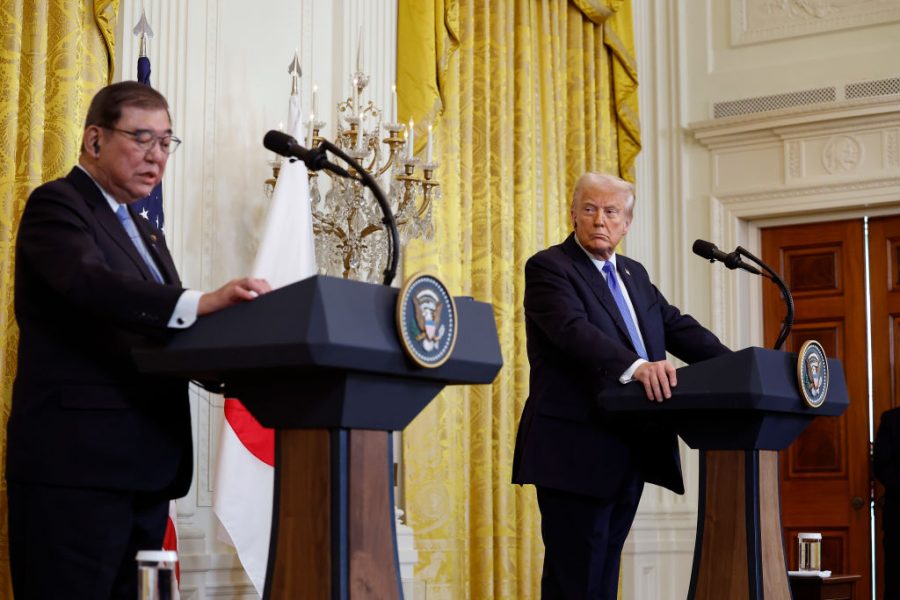‘This is a serious situation for Japan’. That was the verdict of the business editor on NHK’s morning news programme today. Given the normally exquisite understatement of Japanese broadcasters, this kind of language suggests a full-blown crisis is looming. The crisis in question is the Trump administration’s declaration that it would be slapping a 25 per cent duty on all Japanese goods (separate to sectional tariffs already in place) to kick in from 1 August.
This outcome is not set in stone and there is still the possibility of further movement in the remaining three weeks or so. But with Trump calling Japan ‘spoiled’ in recent soundbites and the Japanese negotiators apparently unable even to secure an appointment with Scott Bessent, the US Treasury Secretary, many in Japan are becoming seriously anxious that things are spinning out of control.
Trump seems to believe that Japan is resisting the importation of US rice and cars
Prime Minister Shigeru Ishiba has said that Japan is prepared for all scenarios and would ‘stand firm and defend its interests’. The main interest he is referring to is cars, which have been subject to a 25 per cent tariff since 3 April. It is hard to overstate the importance of Japan’s auto industry, which employs 6 million people, sells 1.5 million cars a year to US customers and accounts for 3 per cent of GDP. For Japan, the high tariff on cars is unacceptable.
There have been seven rounds of trade negotiations so far between Ishiba via his envoy Ryosei Akazawa and team Trump. Things seemed to begin well with the Japanese bearing gifts (a golden samurai helmet), warm words and smiles, the personal presence of Trump at the negotiating table and optimists predicting that a trade deal with Japan would be one of the first the Americans would conclude.
Since then, not much. Trump has labelled the Japanese negotiators ‘very tough’, which probably means they have, to his great surprise, not rolled over. There seems to be an impasse based on fundamental differences of perception. Trump’s view that the trade imbalance with Japan is a result of dirty tricks in the form of non-tariff barriers is fiercely denied here and countered with the assertion that Japan has invested heavily in the US bringing jobs and prosperity.
Trump also seems to believe that Japan is resisting the importation of US rice and cars, which he assumes the Japanese desire. In fact, Japan does import US rice (some 340 thousand tonnes last year) and that is probably as much as is required. Rice is a sacred staple in Japan and the source of much nationalist ‘master rice’ mythologising, with people not keen on the ‘inferior’ Thai or Chinese versions either. And with the recent domestic rice shortage having been somewhat alleviated, there is not much prospect of that changing.
As for cars, it is not a question of prejudice, just preference, for smaller, nimbler and cheaper homemade vehicles designed for a right-hand drive country with an extensive dealership network. Trump, who is driven around in an 18-foot-long, 20,000-pound limousine, may not appreciate the unsuitability of American vehicles on Japan’s narrow twisty neighbourhood roads. Even the rich aren’t interested, with the status seekers, of whom there are few, far more attracted to European marques. US cars made up just 2 per ce t of the Japanese luxury car market in 2024.
It has been speculated by some, including William Pessick, the award-winning Tokyo-based author and commentator, that Trump is stuck in the recent past, and expected Ishiba to behave as did his predecessor Shinzo Abe in his first term. Abe was far more biddable and did more or less what Trump wanted. Ishiba, a bit of an outsider in the Japanese political scene, and not well liked by the Abe faction, is a different and rather stubborn proposition.
His position is weak though: he heads a coalition government and his party was trounced in recent Tokyo municipal elections, but he may see glimmers of hope in marginally improved favourability ratings. This may be down to his tough stance with Trump but also perhaps a qualified success in the recent rice crisis. Prices had risen precipitously until Ishiba appointed Shinjiro Koizumi (son of former Prime Minister Junichiro Koizumi) as a sort of ‘Rice Czar’ to sort it out.
Amazingly, despite a reputation as being a good-looking midwit, Koizumi Jr. has pulled it off – sort of – with the release of stocks of low-grade but edible rice now available at affordable prices. One downside for Ishiba is that he may have set himself up with a serious rival for the future (for those with long memories, the scenario resembles Jim Hacker’s ‘Euro sausage’ triumph in Yes, Prime Minister).
Ishiba remains in charge for now though. He may be gambling that if he can slow-walk the talks with Washington and maintain enough momentum to cling on in this month’s Upper House elections (he probably can) he will be in a stronger position to come back to Trump and serious trade negotiations soon after.
This all assumes that Washington’s tariff threats are Trumpian brinkmanship and a way can be found to delay or defer those potentially devastating duties. It’s a high-stakes game of chicken and time is fast running out.








Comments